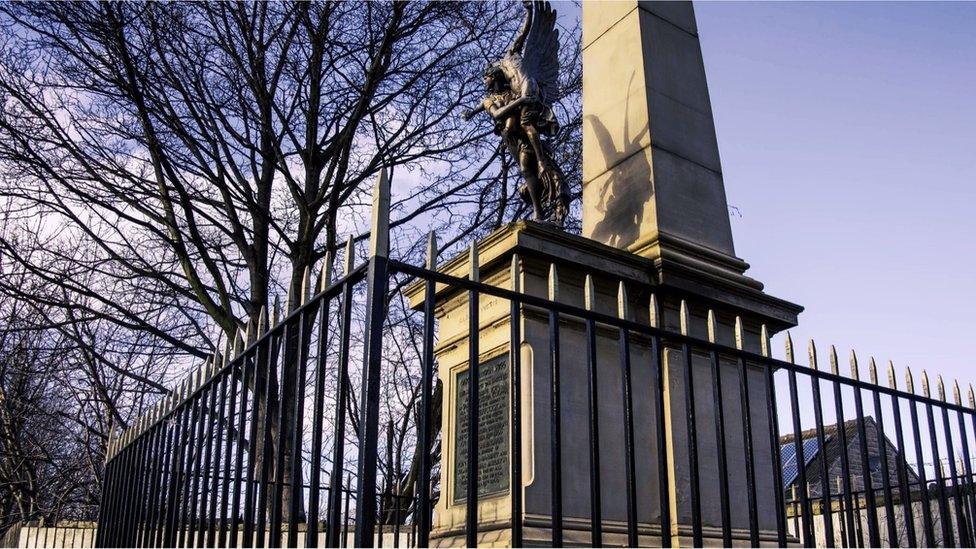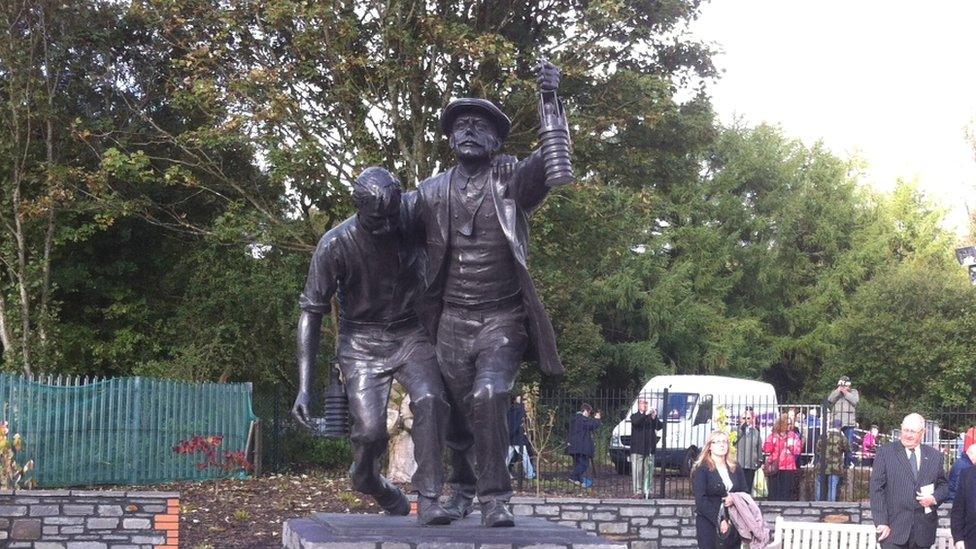The Oaks colliery explosion: England's worst mining disaster
- Published
"When the pit went up it was like a volcano"
In December 1866 a colliery in Barnsley was ripped apart by a series of explosions over two days, killing at least 361 men and boys, in what remains England's worst mining disaster. The events of this largely forgotten tragedy and its devastating effect on the community have been recreated in a new film.
On the fateful morning of 12 December, more than 300 workers started their shifts at The Oaks colliery in Hoyle Mill.
During the afternoon there was a huge explosion. Many volunteer rescuers were still down the pit the next day when another explosion, bigger than the first, took place. Rescue attempts were then halted.

The death toll was recorded as 361 - although recent research puts the figure at 383.
"When The Oaks exploded there was just nothing to compare it with; it was absolutely huge," historian Brian Elliott said.
"The impact was enormous on the communities. Virtually the entire adult male population of several streets in Hoyle Mill was eliminated in an afternoon."
Contemporary accounts describe houses shaking for miles around as coal was blasted upwards, turning the sky dark grey, and depositing a deathly residue, described as "black snow".

Largest loss of life in colliery disasters

Wales - 14 October 1913, Senghenydd - 439 deaths
England - 12-13 December 1866, The Oaks - 361 deaths
Scotland - 22 October 1877, Blantyre - 207 deaths
The largest number of deaths in a single day in England was at Pretoria Colliery, in Westhoughton, in what is now Greater Manchester, on 21 December 1910, where 344 miners lost their lives.
Source: NUM

Researchers for commemorations to mark the 150th anniversary of the disaster soon realised they faced a mammoth task. Volunteers, funded with a lottery grant, spent more than 5,000 hours working on the project.
"There's no one place to go to to get a list of victims," said Stephen Miller, who was the lead researcher with the Dearne Valley Local Partnership (DVLP).
"There are some lists but they are not complete - plus they are just names. We wanted more information: where were these people from, where did they live?
"We wanted to connect with them at a human level so we looked at age profiles and looked to see if children were involved."

Parkin Jeffcock
Parkin Jeffcock was a respected mining engineer.
As soon as he got a telegram informing him The Oaks was on fire he got on a train at Sheffield and travelled to Barnsley.
He and others descended into the pit to assess the damage and help stabilise the conditions for rescuers.

Jeffcock was still down there at 9am the following day when a second, bigger, blast occurred, killing him and 26 other volunteers.
His body was not recovered until 5 October 1867.
St Saviour's Church in High Green, Sheffield, was built as a memorial to him in 1872.
Source: DVLP

Death certificates held in the basement of Barnsley Town Hall were trawled through, burial registers at cemeteries and churches scrutinised, and newspaper articles containing missing persons lists pored over.
"We eventually came up with a list of more than 500 names. But we knew some would be duplicates, or the result of misspellings, so we researched them all," Mr Miller said.
A figure of 383 was eventually reached. Among the dead were boys as young as 10.

Black Snow director Stephen Linstead and others drew on press accounts to help recreate the events of 12-13 December 1866
One of the surprises the research threw up was the geographical spread of the workers.
"We had some from as far as Ireland and Northumberland as well as the coalfield areas of Wales, Nottinghamshire and Derbyshire," Mr Miller said.
"We also had one, James Haycroft, from Shoreditch in east London, which is very strange.
"He was 38 and had married a girl from Barnsley.
"The Sheffield Daily Telegraph reported his body was found two years after the disaster but we could not find a burial record for him.
"His wife identified him by his flannel trousers, belt and boots."

To mark the 150th anniversary of the disaster, a memorial by sculptor Graham Ibbeson was unveiled in the town

The defunct Barnsley Main Colliery sits on the original site of The Oaks, at Hoyle Mill
The task of making a film recreating the events of 12-13 December 1866 proved challenging as, despite the scale of the tragedy, the historical evidence was scant.
Stephen Linstead a filmmaker and professor at the University of York's York Management School, teamed up with Andy Lawrence and Alan "Archie" Andrews to try to recreate the explosion.
Mr Andrews, a miner turned digital artist, recreated the scene using virtual reality.
"I looked at historical illustrations, although these were limited," he said.
"I used sources such as the Illustrated London News but also used my mining background. I knew what many of the buildings would look like.
"It was a mix of artistic licence with background information."

A memorial to the Rescue League, many of whom perished in the second, larger explosion, still stands in Barnsley
"I put the explosion where some stairs would have been, where the clean air would mix with returning air, possibly helping to cause the explosion," Mr Andrews added.
"We do know The Oaks was a very gassy pit."
"We had to use our imagination," director Mr Linstead said.
"We looked through the contemporaneous press accounts and picked out phrases that were of use.
"The virtual reality reflected that there is no final version of history that you can use to get the truth of it."

A banner for the colliery is on display at the NUM's headquarters in Barnsley
The reports that were laid down in Parliament after the disaster gave differing reasons for the explosion.
The first, the inspection report, put the cause down to the shot firing, Mr Linstead said. The second, from the coroner, mentioned a broken lamp being a possible cause.
"The main thing is nothing happened as a result. There was no full inquiry," he said.
"Twenty years later things began to change. But there was no change in legislation following The Oaks."

William Henry Hart
William Henry Hart, originally from Dukinfield in what is now Greater Manchester, was aged 11 and working as pony driver when The Oaks exploded.
He was underground at the time having a break, sitting in an archway with his donkey, Tom, in front of him.

William Henry Hart would go back down the mine when it reopened two years later (Image courtesy of Steve Wyatt)
Tom took the brunt of the blast and Hart survived, although he was badly burned and broke his arm.
He was brought out of the mine by volunteer rescuer William Sugden, who was killed in the explosion the following day.
Hart was among the first miners to go back down the mine when it reopened two years later.
Source: DVLP

NUM secretary Chris Kitchen agreed that although nothing changed immediately after the disaster, it was not long before there was a better system for recording incidents.
This eventually led to the UK's mining industry becoming one of the safest and most highly regulated in the world.
"But it was reactive, rather than proactive," he said.
"A slow learning curve."
Black Snow is being distributed to schools in and around Yorkshire. Anyone who would like a copy should contact the NUM.
- Published7 May 2017
- Published12 December 2015

- Published14 October 2013
